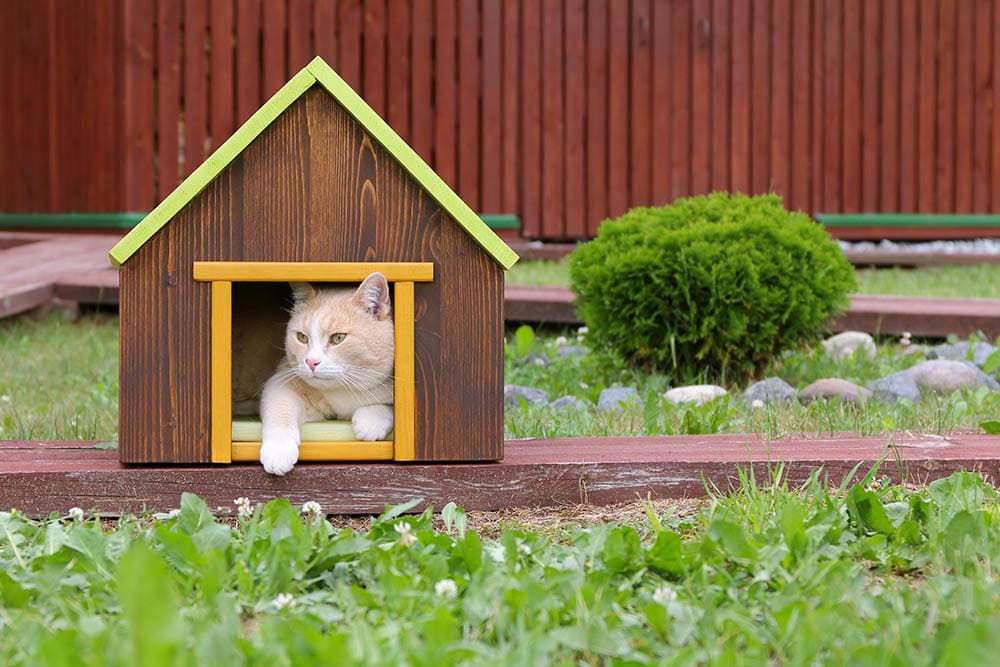VET APPROVED

The information is current and up-to-date in accordance with the latest veterinarian research.
Learn more »Some cat parents may choose to let their cats go outside as much as they want, regardless of the risks that they could face. When neutered or spayed and properly equipped with a microchip, up-to-date vaccinations, and adequate flea/tick and intestinal worm control, some cats, depending on the surroundings, can enjoy outdoor access and then return home for a delicious meal and snooze on the couch. Although some may not have thought about it, this decision should consider the risk posed to local wildlife, mainly birds and small mammals, by the presence of a hunter such as a cat.
But what happens if your outdoor cat runs away? Whether you’ve recently moved to a new area and your pet gets lost or simply ventures out to investigate uncharted territory, a runaway cat can be a danger to themselves and a stressful situation for you.
Here are six proven tips to keep your outdoor cat staying put.

The 6 Ways to Keep Your Outdoor Cat From Escaping
1. Get Them Acclimated
If you’ve moved to a new home, your outside cat needs to get accustomed to their new surroundings before you set them loose. Keep them inside for a few months to help your kitty feel calm and confident in their new environment. Let them explore the garage, porch, and other enclosed areas.
Getting your cat acquainted with their new home will decrease the likelihood of them running off.

2. Daily Feeding Schedule
Keep your outdoor cat on a regular feeding schedule. While this won’t diminish their hunting instinct, a predictable meal schedule will keep your cat always coming back home. Most outdoor cats will come home when they know it’s supper time. Try calling your pet’s name or ringing a bell each day before dinner so they know it’s time to be fed.
3. A Safe Shelter
If your cat spends time outside, you must provide them with an outdoor shelter to protect them from bad weather, too much sun, or simply to relax in peace. Cats without shelters will seek safety elsewhere. Set up a small dog house in your backyard with bedding, a water and food bowl, and your kitty’s favorite toys. You can also install a cat door into your garage or shed so your pet can come and go as they please.

4. Keep It Quiet
Cats can get spooked easily. Alarms, loud voices, music, or even fireworks or gunshots will surely make your cat head for the hills. Limit loud noises in and around your house to keep your outdoor cat feeling secure. If the loud noises are unavoidable, keep your cat inside until things quiet down again.
5. Spay/Neuter Your Cat
If you haven’t done so already, making sure your cat is spayed or neutered is essential to keeping them safe if they have outdoor access. Spayed and neutered cats, won’t be as tempted to wander off in search of a mate, and they will be less likely to engage in fights. Plus, spaying your cat can help ensure that they don’t have an unexpected litter of kittens.
6. Get a Playmate
Cats are social creatures and live in groups in the wild. If you have only one cat, you could consider getting them a friend. It is important to know that while there is no guarantee that they will become good friends, you have better chances of success if you plan it in advance, follow some steps, and consult a professional, whether your vet or cat behaviorist. Having a mate at home will probably stop your outdoor cat from running away since returning home always includes good feline company.


Why Is My Outdoor Cat Running Away?
Outside cats may runoff for several reasons, including:
- Curiosity
- Looking for a mate (if not fixed)
- To escape risk
- As a reaction to stress, such as a recent move
- Getting startled
Make sure your pet is microchipped before letting them outside. Each year, 10 million pets are lost or stolen in the U.S. Of those cats, only 2% of non-microchipped cats were returned to their owners, while 40% of microchipped cats were reunited with their families.


Conclusion
Letting your cat explore the outside world is a decision not to be taken lightly. Some people and organizations claim that this allows them to display their natural behavior, while others consider it an unnecessary risk to both them and the local wildlife. Always get your cat spayed/neutered, provide preventative flea/tick treatments and worming control, and get them microchipped before you let them roam free. To keep them returning home, provide them with a routine feeding schedule, a safe shelter, and even another feline friend.
- See Also: 10 Tips for Making Your Cat Love You
Featured Image Credit: Nils Jacobi, Shutterstock











